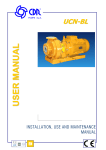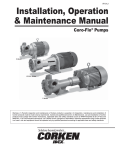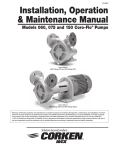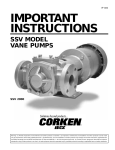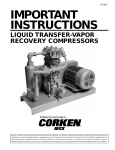Download important instructions coro
Transcript
IF101G IMPORTANT INSTRUCTIONS CORO-FLO® PUMPS C SERIES DS/DL SERIES F SERIES Warning: (1) Periodic inspection and maintenance of Corken products is essential. (2) Inspection, maintenance and installation of Corken products must be made only by experienced, trained and qualified personnel. (3) Maintenance, use and installation of Corken products must comply with Corken instructions, applicable laws and safety standards (such as NFPA Pamphlet 58 for LP-Gas and ANSI K61. 1-1972 for Anhydrous Ammonia). (4) Transfer of toxic, dangerous, flammable or explosive substances using Corken products is at user’s risk and equipment should be operated only by qualified personnel according to applicable laws and safety standards. The Model and Serial Numbers are shown on the nameplate of the unit. Record this information for future reference. Model No. Serial No. Date Purchased Date Installed Purchased From Installed By WARNING Install, use and maintain this equipment according to Corken’s instructions and all applicable federal, state, local laws and codes. Periodic inspection and maintenance is essential. CORKEN ONE YEAR LIMITED WARRANTY Corken, INC. warrants that its products will be free from defects in material and workmanship for a period of 12 months following date of purchase from Corken. Corken products which fail within the warranty period due to defects in material or workmanship will be repaired or replaced at Corken’s option, when returned, freight prepaid to: CORKEN, INC., 3805 N.W. 36th Street, Oklahoma City, Oklahoma 73112. Parts subject to wear or abuse, such as mechanical seals, blades, piston rings, and packing, and other parts showing signs of abuse are not covered by this limited warranty. Also, equipment, parts and accessories not manufactured by Corken but furnished with Corken products are not covered by this limited warranty and purchaser must look to the original manufacturer’s warranty, if any. This limited warranty is void if the Corken product has been altered or repaired without the consent of Corken. All implied warranties, including any implied warranty of merchantability or expressed warranty period. CORKEN DISCLAIMS ANY LIABILITY FOR CONSEQUENTIAL DAMAGES DUE TO BREACH OF ANY WRITTEN OR IMPLIED WARRANTY ON CORKEN PRODUCTS. Transfer of toxic, dangerous, flammable or explosive substances using Corken products is at the user’s risk. Such substances should be handled by experienced, trained personnel in compliance with governmental and industrial safety standards. CONTACTING THE FACTORY Before you contact the factory, note the Model Number and Serial Number of your pump. The Serial Number directs us to a file containing all information on material specifications and test data applying to your specific pump. When ordering parts, the Corken Service Manual should be consulted for the proper Part Numbers. ALWAYS INCLUDE THE MODEL NUMBER AND SERIAL NUMBER WHEN ORDERING PARTS. TABLE OF CONTENTS PRINCIPLES OF THE CORKEN CORO-FLO® PUMP . . . . . . . . . . . . . . . . . . . . . . . . . . . . . . . . . . . . . . . . . Page 4 EXCLUSIVE FEATURES OF YOUR CORKEN CORO-FLO® PUMP . . . . . . . . . . . . . . . . . . . . . . . . . . . . . . Page 4 INSTALLATION OF YOUR CORKEN CORO-FLO® PUMP . . . . . . . . . . . . . . . . . . . . . . . . . . . . . . . . . . . . . Page 4 Inlet Piping Should Include the Following . . . . . . . . . . . . . . . . . . . . . . . . . . . . . . . . . . . . . . . . . . . . . Page 5 Outlet Piping Should Include the Following. . . . . . . . . . . . . . . . . . . . . . . . . . . . . . . . . . . . . . . . . . . . Page 5 By-Pass System Must Include the Following . . . . . . . . . . . . . . . . . . . . . . . . . . . . . . . . . . . . . . . . . . . Page 5 Pump Foundation F-Models . . . . . . . . . . . . . . . . . . . . . . . . . . . . . . . . . . . . . . . . . . . . . . . . . . . . . . . . Page 5 Level Base . . . . . . . . . . . . . . . . . . . . . . . . . . . . . . . . . . . . . . . . . . . . . . . . . . . . . . . . . . . . . . . . . . . . . . Page 8 Coupling Alignment F-Models . . . . . . . . . . . . . . . . . . . . . . . . . . . . . . . . . . . . . . . . . . . . . . . . . . . . . . Page 8 Back-Up Wrench . . . . . . . . . . . . . . . . . . . . . . . . . . . . . . . . . . . . . . . . . . . . . . . . . . . . . . . . . . . . . . . . . Page 8 Driver Installation . . . . . . . . . . . . . . . . . . . . . . . . . . . . . . . . . . . . . . . . . . . . . . . . . . . . . . . . . . . . . . . . Page 8 WIRE SIZE CHART FOR WIRING OF YOUR ELECTRIC MOTOR . . . . . . . . . . . . . . . . . . . . . . . . . . . . . . . Page 9 OPERATION OF YOUR CORO-FLO® PUMP . . . . . . . . . . . . . . . . . . . . . . . . . . . . . . . . . . . . . . . . . . . . . . . Page 10 FILLING NEW CYLINDERS AND TANKS . . . . . . . . . . . . . . . . . . . . . . . . . . . . . . . . . . . . . . . . . . . . . . . . . Page 10 CARE OF YOUR CORO-FLO® PUMP . . . . . . . . . . . . . . . . . . . . . . . . . . . . . . . . . . . . . . . . . . . . . . . . . . . . Page 10 REPAIR SERVICE ON YOUR CORO-FLO® PUMP . . . . . . . . . . . . . . . . . . . . . . . . . . . . . . . . . . . . . . . . . . Page 10 PARTS DETAILS - C-MODEL . . . . . . . . . . . . . . . . . . . . . . . . . . . . . . . . . . . . . . . . . . . . . . . . . . . . . . . . . . Page 11 PARTS DETAILS - F-MODEL . . . . . . . . . . . . . . . . . . . . . . . . . . . . . . . . . . . . . . . . . . . . . . . . . . . . . . . . . . Page 12 PARTS DETAILS - DS/DL MODEL . . . . . . . . . . . . . . . . . . . . . . . . . . . . . . . . . . . . . . . . . . . . . . . . . . . . . . Page 13 INSTALLATION TIPS . . . . . . . . . . . . . . . . . . . . . . . . . . . . . . . . . . . . . . . . . . . . . . . . . . . . . . . . . . . . . . . . Page 14 PRINCIPLES OF THE CORKEN CORO-FLO® PUMP The CORKEN Coro-Flo Pump is a special type of pump known as a turbine or regenerative pump. The liquid flows into the inlet nozzle and into the passageway on each side of an impeller (the rotating element) and is recirculated constantly between the vanes or teeth of the impeller and this passageway as the impeller rotates. The fluid makes a complete revolution in the pump case and is diverted out the outlet nozzle. The horsepower required to drive the pump increases as the differential pressure increases, but the capacity decreases at the same time. (Differential pressure is the difference between the pressure at the inlet of the pump and at the outlet of the pump.) The impeller is the only moving part and has no contact with the casing. Consequently, practically no wear occurs to the impeller, even when pumping volatile liquids such as LP-gas or ammonia which have little lubricating qualities. EXCLUSIVE FEATURES OF YOUR CORKEN CORO-FLO® PUMP The pumping of volatile liquids is one of the most difficult of all pumping jobs. Unlike other pumping operations, more attention must be given to the design, manufacture installation and operation of the pump. In addition to being a pump type especially suited for handling volatile liquids, your CORO-FLO PUMP has a number of features which help to make it more easily operated and maintained. The CORO-FLO PUMPS of this series are manufactured directly connected to the electric motor or with their own frame for connection to a separate driver by means of a flexible coupling. The closecoupled pumps are the models C10, C12, C13 and C14. The frame pumps are available in the F- and DS/DL-models with the following pump sizes: 9, 10, 12, 13, 14 and 15. UNDERWRITERS' LABORATORIES, INC. have tested and inspected the CORO-FLO PUMPS of this series and have listed them for use in the handling of LP-gas and ammonia fluids. The nameplate on the pump shows the UL label. DUCTILE IRON, the metal with the strength of steel, has been used in the manufacture of this pump for parts under pressure of the liquid. 4 CORO-FLO Pumps THE IMPELLER floats on a shaft and may be replaced easily without disturbing the piping or driver by simply removing the cover. No special tools are needed. THE MECHANICAL SEAL ASSEMBLY may be replaced easily by removing the cover and the impeller, and without disturbing the piping or driver. No special tools are needed. THE PUMP NOZZLES MAY BE ROTATED into four different positions, 90 degrees apart, if desired. A BYPASS CONNECTION, 3/4" pipe thread, has been located on the outlet nozzle to make the piping of the pump more simple. PRESSURE GAUGE CONNECTIONS, 1/4" pipe thread, have been located on the outlet nozzle. MOTORS on models C10, C12, C13 and C14 are explosion-proof, Class I, Group D - UL and CSA listed. The C10, C12 and C13 motors are all single phase. 60 Hertz (50/60 Hertz on C13 only), 3450 RPM, 115/230 volt. The C14 motor is three-phase, 60 Hertz, 3450 RPM, 230/460 bolts. Corken can provide manual motor starters for models C10, C12 and C13 with a built-in thermal overload protection. Both motor-mounted and wall-mounted manual starters are available for models C10, C12 and C13. Models C11, C12 and C13 pump motors can be provided with either a motor-mounted or wallmounted manual motor starter with built-in thermal overload protection. These motors (after pump serial number TS185540) are provided with a conduit seal in the 3/4" NPT rigid galvanized steel nipple, fulfilling the 1996 requirement of NFPA 70-NEC, paragraphs 501.5.a.1 & 3. Separate motor starters with overload protection must be provided for the model C14 and all F series pumps. INSTALLATION OF YOUR CORKEN CORO-FLO® PUMP THE INSTALLATION OF A CORO-FLO PUMP is a simple matter. However, in order for the pump to deliver the performance you expect, the principles discussed in this book must be followed exactly. The piping details are furnished to illustrate methods proved by hundreds of installations. Your own needs may require some slight variations, but they must be slight, and no compromise made. For more detailed piping arrangements, request Engineering Data book Z400. For a discussion of pumping from underground tanks see Corken Engineering Bulletin #6. 8. The minimum inlet piping sizes shown in Figures 1 and 2 must be observed. IF IT IS DESIRABLE TO ROTATE THE NOZZLES of the pump to a new position, remove the four cap screws connecting the pump case (Figures 7, 8, 9) to the motor or the frame. Be careful to do this without moving the case away from the motor or frame; otherwise, the mechanical seal may be damaged. 1. A pressure gauge should be installed in the opening provided on the outlet nozzle or in the outlet piping near the pump. This pressure gauge will tell you the complete story of the operation inside your pump. Be sure you have one installed. NO PUMP CAN DISCHARGE MORE LIQUID THAN IT RECEIVES, so the location and the inlet piping must be given careful attention. If the inlet piping is inadequate to supply the demand of the pump, you may expect trouble! The inlet line sizes shown on Figures 1 and 2 are the smallest size piping you can use with success. THE PUMP MUST BE LOCATED AS NEAR THE STORAGE TANK as possible. The complete inlet line, including the vertical line from the tank must not exceed 12 feet in length. The bottom of the tank must be at least two feet above the pump inlet nozzle, and four feet should be considered standard. THE INLET SHOULD INCLUDE THE FOLLOWING: 1. The tank excess flow valve should have a flow rate of 1-1/2 to 2 times the capacity of the pump. Do not use an EVF without knowing its flow capacity. 2. The tank shutoff valve should be an angle valve or a free flow type – not a standard globe valve. 3. A strainer of the "Y" type, with 1/16" mesh screen, must be on the inlet line of the pump. For simpler inlet lines use a Corken 1836-X1 Right Angle Strainer to replace an elbow and "Y" strainer. 4. A flexible connection should be used on the pump inlet or outlet to care for piping strains. 5. Unions must be installed near the pump inlet and outlet nozzles. THE OUTLET PIPING SHOULD INCLUDE THE FOLLOWING: 2. A hydrostatic relief valve is required to be installed in the outlet piping. 3. If the outlet piping exceeds 50 feet in length, a check valve should be installed near the pump outlet. 4. The minimum outlet piping sizes shown in Figures 1 and 2 must be observed. THE BYPASS SYSTEM MUST INCLUDE THE FOLLOWING: 1. The pump bypass system must be installed. Without this system, the pump has little chance of performing. 2. A CORKEN B166 BYPASS VALVE (a special valve to vent the pump of vapors and to act as a differential relief valve) makes the ideal installation. 3. The bypass line must rise uninterrupted to an opening in the vapor section of the storage tank. The tank fitting must be either an excess flow valve or a vapor return valve; it should never be a filler valve or a back check valve. PUMP FOUNDATION F-MODELS Every pump deserves a firm, neat concrete foundation. There are many ways to construct a foundation, and the example in Figure 3 is only a suggestion. The important features are to make the foundation level, and deep enough to get below the frost line for your locality. 6. An eccentric swage should be used at the pump inlet nozzle to change line size (flat side up.) 7. The inlet line must be level or slope downward to the pump. CORO-FLO Pumps 5 FIGURE 1 23 VAPOR LINE FROM METER VAPOR ELIMINATOR OR METER BACK PRESSURE VALVE 24A 24 21 22 25 20 18 19 1 2A 2 3 EITHER CORO-FLO FRAME F-MODELS OR CLOSE-COUPLED C-MODELS CAN BE USED. 17 13A 13 12 4’ - 0” RECOMMENDED DISTANCE 18 11 15 14 10 12 11 4 6 8 9 5 5A 7 9A 16 Item No. MOTOR FUELING IF DISCHARGE LINE IS OVER 50 FEET LONG, INSTALL A CHECK VALVE BETWEEN VALVE 15 AND TEE 16. CYLINDER FILLING 6 CORO-FLO Pumps 1 2 2A 3 4 5 5A 6 7 8 9 9A 10 11 12 13 13A 14 15 16 17 18 19 20 21 22 23 24 24A 25 26 Description Size of Fitting in Inches Model C10 F9, F10 Model C12, C13 F12, F13 Model C14 F14 1-1/4 1-1/4 --1-1/4 1-1/4 1-1/4 --1-1/4 1-1/4 1-1/4 1-1/4 --1 1 1 1 x 3/4 --1 x 1/2 1/2 1 3/4 3/4 3/4 3/4 --3/4 3/4 3/4 --3/4 1/4 2 --2 x 1-1/2 1-1/2 1-1/2 1-1/4 1-1/2 x 1-1/4 1-1/2 1-1/2 1-1/2 1-1/2 --1 1 1 1 x 3/4 --1 x 1/2 1/2 1 3/4 3/4 3/4 3/4 --3/4 3/4 3/4 --3/4 1/4 2 2 --2 2 2 --2 2 2 --2 x 1-1/2 1 1 1 --1 1 x 1/2 1/2 1 1 1 1 1 1 x 3/4 3/4 1 --1 x 3/4 3/4 1/4 Excess Flow Valve Nipple Swage Nipple Shutoff Valve Tee Double Check Filler Valve Bushing Strainer with 1/16 Mesh Screen Flexible Hose Connection with Male Hose Connection Union Nipple Swage Nipple Union Tee Shutoff Valve Swage Nipple Nipple Bushing Hydrostatic Relief Ell Corken Bypass Valve B-166 Ell Union Tee Swage Nipple Vapor Return Valve Angle Valve Nipple Swage Nipple Excess Flow Valve Pressure Gauge with 1/4” x 2” Nipple and 1/4” 90° Ell FIGURE 2 PIPING YOUR CORO-FLO PUMP 12 11 COPPER TUBING 1 2 3 18 17 14 4 10 9 13 5 8 7 16 15 19 19 6 NOTE: PIPE, VALVES, FITTINGS AND ELECTRICAL WIRING MUST BE IN ACCORDANCE WITH LOCAL, STATE OR FEDERAL CODES, STANDARDS AND REGULATIONS HAVING JURISDICTION. REF. NFPA 58 “STANDARDS FOR THE HANDLING OF LIQUEFIED PETROLEUM GASES” BILL OF MATERIALS C-10, F10 QUAN. SIZE, INCHES C12, F12 C13, F13 SIZE, INCHES 1 2 3 4 5 6 7 8 9 10 11 1 1 1 1 1 1 1 1 1 1 1 1-1/4 1-1/4 x 4 1-1/4 1-1/4 1-1/4 1-1/4 1/4 NPT 1 x 3/4 3/4 3/4 3/4 FPT x 1/2 SAE Flare 1-1/4 1-1/2 x 1-1/4 Swage 1-1/2 1-1/2 1-1/2 1-1/2 1/4 NPT 1 x 3/4 3/4 3/4 3/4 FPT x 5/8 SAE Flare 12 13 14 1 1 1 3/4 x 1/2 1/2 x 10’-0” None 3/4 x 10’-0” 15 16 1 1 17 1 18 19 1 2 1/2 1/2 MPT x 1-3/4 6 Acme (Female) 1/4 FPT x 1-3/4 6 Acme (Male) 1/4 MPT x Male POL 1-1/4 x 4 3/4 3/4 MPT x 1-3/4 6 Acme (Female) 1/4 FPT x 1-3/4 6 Acme (Male) 1/4 MPT x Male POL 1-1/2 x 4 ITEM DESCRIPTION Excess Flow Valve Swage or Nipple LPG Shutoff Valve X.H. 90˚ Ell L.P.G. Strainer with 1/16 Mesh Screen X.H.G.J. Union Pressure Gauge 2-1/2” Face bottom connected Concentric Steel Swage X.H. Tee Corken By-Pass Valve with Hydrostatic Relief Tube Adapter O.D. Tubing Excess Flow Valve Hex Steel Bushing Single Wire Braid Hose with Male Couplings Both Ends L.P.G. Shutoff Valve Filler Valve Coupling Adapter Cylinder Filling Connector with Handwheel Extension X.H. Nipple CORO-FLO Pumps 7 threads are clean and well doped with the proper thread seal for the service. Avoid using excessive dope, for it may enter the pump and damage the mechanical seal. Figure 3 LEVEL BASE After the concrete has set, check the pump base for level. Drive metal shims under the base near the anchor bolts as below. Tighten anchor bolts and recheck the base for level. Figure 4 COUPLING ALIGNMENT F-MODELS The coupling alignment must be near perfect to give quiet, long-life service to the pump and driver. The pump and driver shafts are carefully aligned at the factory but always should be checked after the pump is installed and before the initial operation. Lay a straight edge across coupling halves, top, and side; both positions must line up to be correct. If misalignment exists, adjust the shims between the pump base and the foundation until exact alignment is accomplished. Figure 5 BACK-UP WRENCH To keep from breaking the pump nozzle or springing the pump out of alignment, always use a back-up wrench as shown in Figure 6. Use the proper wrench size, and be sure the pipe 8 CORO-FLO Pumps Figure 6 DRIVER INSTALLATION THE WIRING OF YOUR ELECTRIC MOTOR is extremely important and must be done by a competent electrical contractor. The wire size chart on page 6 indicates the minimum standards for wire sizes. Improper motor wiring will cause you to experience expensive motor difficulties from low voltage. If you suspect you have low voltage, call your power company. Connecting your motor for the voltage you have available is important too. Be sure your motor is connected to the proper voltage. Connecting to improper voltage will completely destroy your motor. In explosion-proof motor applications in humid climates, the normal breathing and alternating temperatures of the motor (warm during operation and cold when stopped) will often cause moist air to be drawn into the motor housing. This moist air will condense and may eventually add enough free water to the inside of the motor to cause it to fail. To prevent this, make a practice of running the motor and pump at least once a week on a bright, dry day for an hour or so (pump through the bypass system). During this time, the motor will heat up and vaporize the condensed moisture. No motor manufacturer will guarantee his explosion-proof or totally enclosed motor against damage from moisture. ENGINE DRIVERS pose a special consideration. The manufacturer's instructions must be followed. When the CORO-FLO PUMP is equipped with an engine from the factory, the engine speed should normally not exceed 3600 rpm. Excessive engine speed will overload the engine and cause early failure. The engine loses 3% of its power for every 1000 feet above sea level, so if your installation is at a higher altitude than normal, consult the factory. MOTOR MODEL HP. MOTOR PHASE (a) RECOMMENDED WIRE SIZE, AWG VOLTS LENGTH OF RUN IN FEET APPROX. FULL LOAD AMPERES 0-100 TO 200 TO 300 C9 C10 3/4 1 115 230 9.0 5.0 12 12 8 12 6 12 C12 1 1 115 230 16.0 8.0 8 12 6 12 4 10 C13 2 1 115 230 20.0 10.0 8 12 4 10 2 8 C14 3 3 12 10 12 8 *P1 Should be connected to the ungrounded line. 230 460 8.0 4.0 12 12 Pump must rotate in the direction shown on pump case. If not, switch any two of the three incoming 3 phase lines. 3/4 1 3 1 1 3 1-1/2 1 3 2 1 3 3 1 3 5 1 3 7-1/2 1 3 T3 115 230 230 460 10.0 5.0 2.8 1.4 12 12 12 12 8 12 12 12 6 12 12 12 115 230 230 14.0 7.0 3.6 1.8 10 12 12 12 6 12 12 12 6 12 12 12 115 230 230 460 18.0 9.0 5.2 2.6 8 12 12 12 6 12 12 12 4 10 12 12 115 230 230 460 24.0 12.0 6.8 3.4 8 12 12 12 4 10 12 12 2 8 12 12 115 230 230 460 34.0 17.0 9.6 4.8 6 12 12 12 4 8 12 12 2 8 12 12 115 230 230 460 56.0 28.0 15.2 7.6 4 10 12 12 1 6 12 12 1/0 4 10 12 230 230 460 40.0 22.0 11.0 8 10 12 6 10 12 4 8 12 LINE T1 T1 T1 T1 L1 T3 T4 LINE T4 L2 LINE LINE LINE LINE • LINE T2 LINE L1 LINE T2 T2 LINE T2 L2 CORO-FLO Pumps 9 OPERATION OF YOUR CORO-FLO® PUMP The following steps should be performed for the initial pumping operation: pressure down to a reasonable limit. Don't blame your pump for not filling a small container! A properly fitted cylinder and filling manifold or connection will permit filling with not more than 50 to 60 psi differential pressure. 1. Close shutoff valve on the end of the delivery hose. 2. Open the storage tank bottom shutoff valve. 3. Open the storage tank shutoff valve of the bypass system. 4. Check the motor for the proper voltage. (See instructions under driver installation.) 5. Start the pump and circulate liquid through the bypass system. 6. Adjust the B166 bypass valve by turning the adjusting screw out until the pump pressure gauge shows nearly the same pressure it did before you started the pump. Screw the adjusting screw in until the pressure gauge indicates the pump is starting to lose discharge pressure (you will know this by the rapid fluctuating of the pointer); then back the adjusting screw out a turn or two until the pressure gauge again indicates a steady pressure. Lock the lock nut, and permit the pump to circulate liquid for a half hour or more. If the motor overload protection device stops the motor during this period, this indicates the bypass system valve is set too high and should be readjusted by turning the adjusting screw out until the motor will run for this period. FILLING NEW CYLINDERS AND TANKS All new containers are full of air and since air will not liquefy under reasonable filling pressures, it must be purged. To assure relatively easy filling and the proper gas supply to burners and carburetors, purging air from new containers is esseÏntial. Some cylinders are difficult to fill because they are equipped with a fill tube that extends down into the liquid portion of the container. If possible, these cylinders should be refitted, so the incoming liquid enters the vapor section of the cylinder. If refitting is impossible or impractical, rock the cylinder as it is being filled so that liquid will splash up into the vapor section – this will help keep the cylinder filling 10 CORO-FLO Pumps CARE OF YOUR CORO-FLO® PUMP The only maintenance necessary on this pump is to lubricate the bearings about once every six months. The Bearings have been lubricated at the factory for the initial operation. LUBRICATION FOR MODELS C10, C12, C13 These models are equipped with lifetime lubricated bearings. LUBRICATION FOR MODELS F9, F10, F12, F13, F14, F15, DS/DL 9, 10, 12, 13, 14, AND 15 There are two bearings on the pump frame of these models that require lubrication. In addition, if the pump is driven by a motor there may be two bearings on the motor to lubricate at the same time you lubricate the pump bearings. If the driver is an engine, follow the engine manufacturer's instructions. LUBRICATING BALL BEARING IS SIMPLE. Use only Ball Bearing Grease – nothing else will do. Remove the plug or fitting over the bearing, add a small amount of grease, and run the pump and driver for several minutes with the plug removed. The bearings will pump out the excess grease. Replace the plug. REPAIR SERVICE ON YOUR CORO-FLO® PUMP After a long service life, repairs are limited to replacing the impeller or mechanical seal. The only wearing part influencing the pumping action is the impeller, so we suggest the pump be given an "efficiency" test before any attempt is made to repair it. The trouble may lie in the piping system rather than in the pump. If the pump will still produce as much differential pressure when circulating through the bypass system as it did when new, you may be sure your problem is elsewhere. If the pump does not produce as much pressure as it did originally, remove the cover in Figure 7, 8 or 9, and inspect the impeller. If visual inspection indicates the impeller is in good condition, remove the thin shim gasket and replace the cover. Many times this procedure will adjust for slight Impeller wear. If the Impeller is badly damaged, it must be replaced. use for pulling. The new impeller must be a good slip fit on the shaft; it should "float" on the shaft, so it may be necessary to sand the shaft lightly to get the proper fit. REPLACING THE IMPELLER is a matter of removing the cover and removing the old impeller from the shaft. If the old impeller is tight on the shaft, threaded bolt holes are provided in the impeller to REPLACING THE MECHANICAL SEAL is a simple matter, and replacement parts are immediately available. Clear instructions are furnished with the replacement seal assembly for its installation. FIGURE 7 PARTS DETAILS - C MODELS Motor Woodruff Key Socket Head Cap Screw Pan Head Screw Nameplate Pipe Plug, 3/4” NPT Pipe Plug, 1/4” NPT O-ring Adapter Ring Case Hex Head Cap Screw Housing Adj. Shim Seal Housing Seal Assembly Impeller O-ring Case Clearance Shim Cover CORO-FLO Pumps 11 FIGURE 8 PARTS DETAILS - F MODELS Pan Head Screw Case Pipe Plug 3/4” NPT Nameplate Pipe Plug 1/4” NPT O-ring Housing Adj. Shim SOC Head Screw Grease Zerk Seal Housing Steel Seal Assembly Impeller O-ring Case Clearance Shim Cover Frame Ball Bearing Key Shaft Hex Head Cap Screw 12 CORO-FLO Pumps #5 Woodruff Key Bearing Retainer Ring Ball Bearing Bearing Retainer Ring Grease Seal Bearing Cap Bearing Retainer Ring FIGURE 9 PARTS DETAILS - DS/DL MODELS Pan Head Screw Pipe Plug, 3/4” NPT Nameplate Case Pipe Plug, 1/4” NPT O-ring Housing Adj. Shim Seal Housing Steel Seal Assembly Seal Pin Impeller Socket Head Screw Grease Zerk O-ring Case Clearance Shim Cover Hex Head Cap Screw Frame DS/DL Bearing Retainer Ring Ball Bearing Key Shaft #5 Woodruff Key Ball Bearing Bearing Retainer Ring Grease Seal Bearing Cap Bearing Retainer Ring CORO-FLO Pumps 13 INSTALLATION TIPS 1 No! 2 Yes! Use inlet line larger than pump suction nozzle. Same size nozzle OK on short runs. Don’t use restricted inlet line! Pressure drop caused by restriction in suction line will cause vaporization and cavitation. 3 No! 4 Yes! Eccentric Reducer Concentric Reducer An eccentric reducer should always be used when reducing into any pump inlet where vapor might be encountered in the pumpage. The flat upper portion of the reducer prevents an accumulation of vapor that could interfere with pumping action. 5 No! Don’t allow bypass line to have low spot. 6 Yes! Keep return line level or go up toward tank! Low spots in bypass line can collect liquid which prevents normal vapor passage for priming purposes just like the P trap in the drain of a kitchen sink. This is not a problem for bypass lines where vapor elimination is not required. 14 CORO-FLO Pumps INSTALLATION TIPS 7 Yes! 8 No! Never locate pump above level of liquid feeding pump. Product must be able to flow by gravity into pump. Always locate pump below tank level ...the lower the better! Since liquefied gases boil when drawn into a pump by its own suction, the pump must be fed by gravity flow to give stable, trouble-free operation. No! 9 Back Check Valve Positive closure of back check valve prevents proper vapor return for pump priming. 11 No! Don’t pipe bypass line back into suction piping! Heat Building in recirculated products causes flashing of liquid to vapor with immediate cavitation and ultimate dry-running. This is why the bypass relief valves which are built into many positive displacement pumps should not be used for normal bypass action when handling liquefied gases. The internal valve should be considered to be a back-up safety relief in in addition to a back-up safety relief in addition to a back-to-tank bypass valve and should be set to relieve at pressure 10 to 20 psi higher than the working bypass. Some built-in bypass valves have the capability of being piped back-to-tank so check with the pump manufacturer. Yes! 10 Excess Flow Check Valve Necessary for proper vapor elimination when using priming type bypass valves. 12 Yes! Always pipe bypass back to tank! Make sure bypass line is large enough to handle full pump flow without excessive pressure build-up. Note that bypass line must be capable of bypassing full pump capacity without excessive pressure build-up. High pressure rise can cause bypass valve to chatter and vibrate. CORO-FLO Pumps 15 P.O. Box 12338, Oklahoma City, OK 73157 3805 N.W. 36th St., Oklahoma City, OK 73112 Phone (405) 946-5576 • Fax (405) 948-7343 E-mail [email protected] Web address www.corken.com Printed in U.S.A. November 1999
















